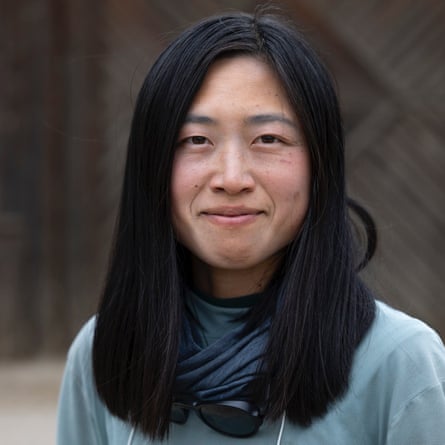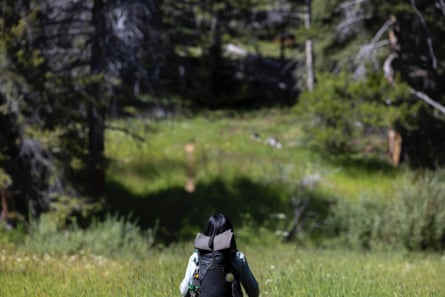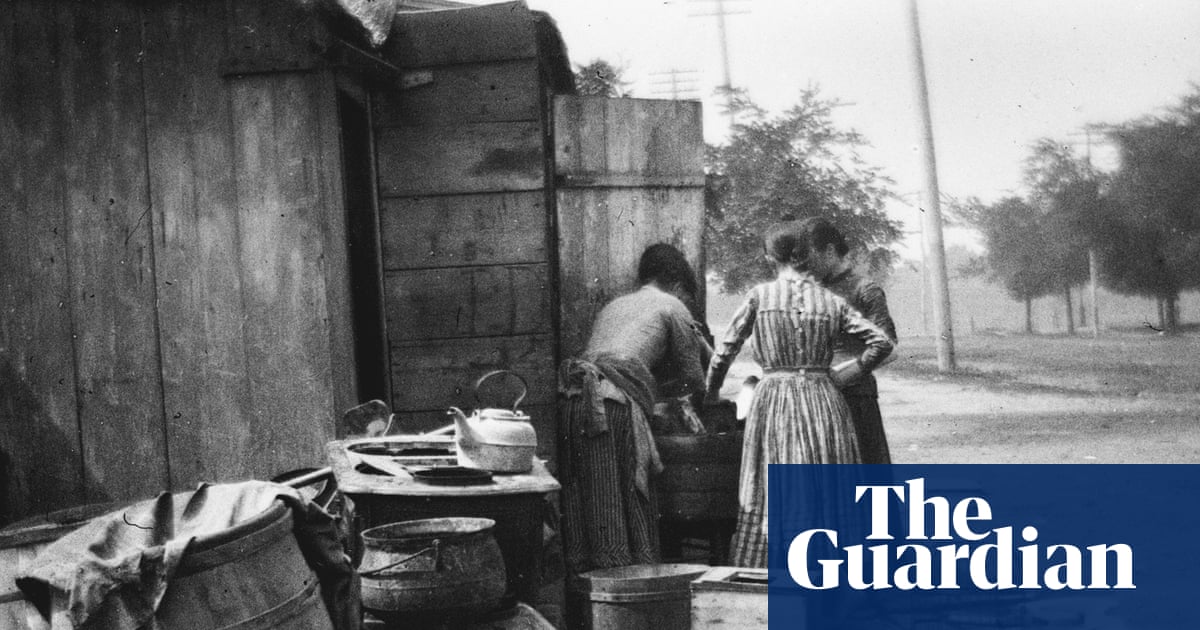Jessica Guo had only slept for two-and-a-half hours on an overnight bus when she arrived at the Mexico-US border near Lordsburg, New Mexico, in April. Out of the window she saw a flat, shadeless landscape. First-day jitters had Guo questioning what she was doing there.
The former consultant had left corporate America to attempt something no woman had completed: a single, continuous hike of the Continental Divide Trail (CDT) and the Great Divide Trail (GDT) in one calendar year.
The rare linking up of the two trails – which traverse New Mexico’s Chihuahuan Desert, Colorado’s high-elevation passes, Old Faithful in Yellowstone national park in Wyoming, the alpine scenery of Montana and Glacier national park and the remote backcountry of Banff, Canada – captivated tens of thousands of viewers online as Guo recorded and edited her daily journeys, while keeping a pace of around 48km (30 miles) each day.

She completed the epic, five-month-long trek in September, becoming the first female hiker to do so – and decided to leave her six-figure job for good to spend more time helping others get on trail.
“I didn’t start out as some crazy endurance athlete and I really think of myself as a normal person,” she said of the 5,698km (3,541-mile) hike, which has been completed by only three men since 2005. “I was scared about sleeping outside alone in the woods or hiking alone or in the dark when I first started backpacking nearly a decade ago.”
Her short, narrated videos, which feature landscapes ranging from hot deserts to snowy peaks, were originally meant for family, friends and other hikers. But it wasn’t long before a larger community became invested in them; she now counts nearly 50,000 followers on her Instagram account. Guo documented her progress each day, editing on the go during easier sections of the trail, and would text the files to her brother when she had cell service so he could upload them on her behalf.
Guo, who turned 30 on the trail, battled everything from swarms of mosquitoes and thick mud and snow to rocky ridgelines and dense forests (spotting bears, caribou and 193 species of birds along the way) as she gained 179,450 meters (588,747ft) in elevation – the equivalent of hiking Everest 20 times.
On 19 September, day 152, Guo reached the end of her journey, posting an emotional video from the remote Kakwa Lake in the Rocky Mountains in British Columbia, Canada. “If there’s something out there that calls to you, I hope you listen,” she said. “Give yourself permission to do the thing.”
‘It’s hard when you don’t see people who look like you’
Although Guo was raised in a suburb outside of Seattle, where she was regularly exposed to nature during hiking and camping trips with her family, it took many years for her to give herself the permission to do something extraordinary.
It was on a pivotal trip to Panama after high school, which she earned by selling Girl Scout cookies, that Guo learned of the Pacific Crest Trail (PCT), which spans the US border with Mexico to the Canadian border and was made famous by Cheryl Strayed’s 2012 memoir Wild. She liked the idea of hiking through her home state, but was intimidated.

“I think a lot of women tend to underestimate what they can do, and feel like we have to be overly prepared,” she said. “I later realized you don’t have to feel like you’re 100% ready to go after it. We’re not really conditioned to think that way as women.”
The percentage of women hiking and backpacking has been increasing over the years. In 2018, women represented one-third of thru-hikers – people who hike a long-distance trail end to end in one expedition – but 2024 Appalachian Trail (AT) and PCT surveys showed nearly half of all long-distance thru-hikers identified as women. Even so, Guo has encountered “benevolent sexism” – men underestimating her capabilities or acting as protectors – both on the trail and in the comments sections of her posts. A few people on the trail seemed surprised that she was an Asian woman, and other Asian hikers have told Guo they have been mistaken for her.
“I hope we have more and more diversity to the point where you don’t have to comment on it,” said Guo, who is the daughter of Chinese immigrants. “It’s hard when you don’t see people who look like yourself doing the things you want to be doing.”
Guo finally made her 10-year dream of hiking the PCT come true in 2023. She picked up her trail nickname, “Stitches”, after a branch impaled her calf and she needed six stitches, and another incident involving a sharp rock where her knee received three stitches.
From post-trail depression back to the trail
The joy of her accomplishment was short-lived as she quickly experienced post-trail depression and, later, a severe clinical depression after returning to her day-to-day life as a design strategist and facilitator at a consulting firm. “You’ve just been in this place where you’re getting dopamine every day, being outside and tuned into nature and then coming back to work and a 9-to-5 and being sedentary,” she said. “It’s a big shift.”

Her doctor told Guo she needed to get back on trail to remember who she was.
Last year, she took medical leave and hiked the Colorado Trail (CT) in about a month. “That was really empowering because previously I wasn’t eating, I wasn’t sleeping, I wasn’t moving outside. I wasn’t doing all the things that keep you alive and well, but those are also the things I have to do when I’m on trail,” she said. “I have to move forward, I have to eat, I have to sleep.”
Seeing the progress she made on the CT helped Guo heal from depression and find a new dream. That’s when she came up with the idea of linking the CDT and GDT, but found there was virtually no information available about doing both hikes. She decided she would blaze her own trail and document it so future hikers could follow her example.
Guo’s CDT and GDT hikes were largely solitary, which gave her time to think and write about her experiences, which included witnessing the effects of climate change first-hand.
In one post, Guo wrote: “I did not start this hike intending to talk about climate, but it is untenable, the effect we are having. You may not see it in your homes because you turn on the tap and clean fresh water comes out. And I am at the source and I see the glaciers dwindling. I see that there is supposed to be a glacier here, but there is nothing. And that scares me.”
She also spoke about the current threats to public lands and the roadless rule, which protects the US’s backcountry recreation areas. “The whole point of being out there is to be in that isolated space,” she said, “and I think it’s worth preserving.”

When Guo saw the end of the GDT trail, she was overwhelmed with emotion and began to cry.
“I thought about how I had walked along the ridgeline of North America that is the source of the water nourishing so many millions of people in two countries, nurturing so many millions of creatures and plants and ecosystems,” she said. “It was humbling, and reaching the terminus the next day, I felt joy, relief, grief and pride. It was bittersweet to know that the end was here.”

 2 hours ago
6
2 hours ago
6

















































